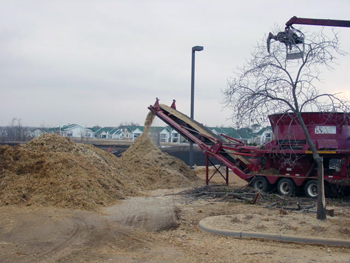Wood Mulch From Trees
Return to Miscellaneous Agent Articles
 Mountains of shredded wood could be found all over Johnson County after the severe ice storm of January 2002. The piles were the result of the thousands of trees damaged in the storm. The broken branches were chopped and made available for landscape use. The Johnson County Extension Office received numerous calls about this storm by-product.
Mountains of shredded wood could be found all over Johnson County after the severe ice storm of January 2002. The piles were the result of the thousands of trees damaged in the storm. The broken branches were chopped and made available for landscape use. The Johnson County Extension Office received numerous calls about this storm by-product.
Why mulch the landscape?
The use of mulch is one of the best practices in the landscape and garden. Mulch
- conserves moisture,
- controls weed growth,
- cools the soil for root development, and
- eventually breaks down into black gold, organic matter, to improve our heavy clay soils.
The blanket recommendation is for all exposed soil in the landscape to be covered with two to four inches of mulch. Shredded wood from broken tree limbs provides the benefits of mulching.
Disadvantages of wood mulch from ice damaged trees
There are two main drawbacks to this kind of wood mulch. First, the mulch is mainly composed of soft wood, which will deteriorate at a fairly rapid rate. The mulch is from soft wooded trees such as elm, silver maple, Bradford pear and others. This rapid rate of decomposition means the mulch layer may only last a season or two before it needs to be replaced. Secondly, the mulch is fairly course. Gardeners often prefer mulch that has a finer texture and darker color. A fine texture and dark color often blends better with plant foliage and flowers.
In the big picture mulch is mulch. It has a function and a purpose. In some ways it can be compared to an automobile. A bargain car will get you there the same as the most expensive car. The issue is how do you prefer to get there? Tree mulch has the right characteristics for function and purpose. The question is, what look do you prefer in your landscape?
Does wood mulch lead to termites?
Questions often arise about the use of wood mulches around the home and the problem of termites. Termites do feed on wood, but it must be a cool, moist enclosed environment. Mulch laying on the soil surface heats up and dries out. It is the soil below that stays cool and moist. A surface layer three to four inches deep should not become a termite haven. If the mulch becomes buried in the soil or deeper, then termites are likely to find it a tasty source of food. Never place wood mulch or soil in contact with wood siding as decay will occur.
Those in need of an inexpensive source of mulch may find wood mulch a blessing in disguise. The kind of mulch will benefit the landscape and garden in many ways. It just may not look the best.

Have questions? The Garden Hotline is staffed by trained EMG volunteers and Extension staff who will assist you with questions.
Phone: (913) 715-7050
Email: garden.help@jocogov.org